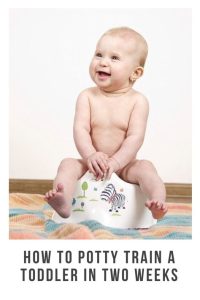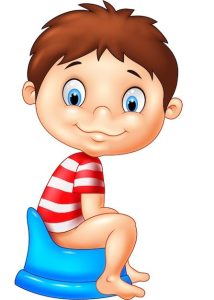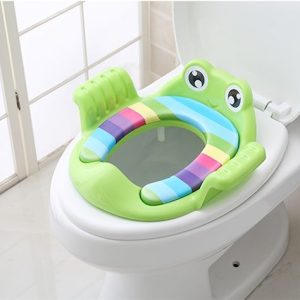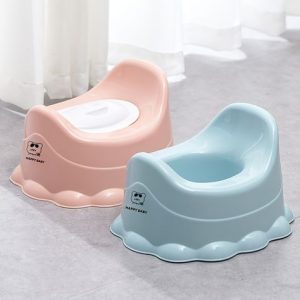Introduction
Every child develops at their own pace, and potty training is no exception. There’s no magic age for a child to be “ready.” This article explores signs that your 2-year-old might be developmentally ready to start potty training, along with tips and a sample schedule to get you started.
Understanding Potty Training Readiness
There’s no one-size-fits-all approach to potty training. However, some signs can indicate your 2-year-old might be developing the physical and mental skills needed:
Physical Development:
Can your child pull their pants up and down independently? Do they show discomfort in a wet or dirty diaper?
Following Routines:
Does your child show interest in routines and try to imitate adults using the toilet?
Verbal Cues:
Has your child started using words for pee or poop? Do they seem curious about the toilet?

It’s Okay to Wait!
If your child isn’t showing these signs yet, don’t pressure them. Trying to potty train before they’re ready can lead to frustration for both you and your child.
Creating a Potty-Friendly Environment
Here are some ways to create a positive and supportive environment for potty training:
- Invest in a Potty Chair: Choose a colorful and comfortable potty chair sized for your child. Let them explore it at their own pace.
- Stock Up on Potty-Training Books: Look for books with simple language and illustrations that introduce the concept of using the potty in a positive way.
- Open Communication is Key: Use simple language to explain what happens when you use the toilet and how it works. Answer their questions honestly and openly.

Sample Potty Training Schedule for 2-Year-Olds
Here’s a sample potty training schedule for a 2-year-old. Remember, this is just a starting point, and you’ll need to adjust it based on your child’s individual cues and needs.
- Morning: After waking up, take your child to the potty before breakfast.
- Mid-Morning: Offer potty time again, around mid-morning, even if they don’t go.
- Lunchtime: Before and after lunch can be good times to try the potty.
- Afternoon: Offer potty time in the mid-afternoon and before nap time.
- Evening: Before dinner and bedtime, take your child to the potty.
Be Flexible and Patient!
This is just a sample schedule, and there will be bumps along the road. Be flexible and patient with your child. Accidents happen!
Making Potty Time Positive
Here are some ways to make potty training a positive experience for your 2-year-old:
- Positive Reinforcement: Celebrate successes with stickers, praise, or a fun activity.
- Relaxed Atmosphere: Make potty time fun and engaging with songs, books, or games.
- Focus on the Journey: Potty training is a learning process. Focus on celebrating small victories and making it a positive experience for your child.

If you have concerns about your child’s potty training progress, talk to your doctor. They can address any underlying medical issues and offer additional guidance.
Potty training can be a rewarding experience for both you and your child. By following your child’s lead, creating a supportive environment, and celebrating their progress, you can make this milestone a positive one.
Building a Routine: Sample Potty Training Schedule for 2-Year-Olds
Remember, every child develops at their own pace. This sample schedule is a guideline to help you get started. Be prepared to adjust it based on your child’s individual cues and needs.
Morning: After waking up and before breakfast is a great time to introduce the potty. This routine establishes using the potty as part of the morning wake-up process.
Mid-Morning: Around mid-morning, even if your child doesn’t use the potty, offer them the opportunity to sit for a few minutes. Consistency is key in potty training, so sticking to these times will help your child become familiar with the routine.
Lunchtime: Before and after lunch can be good times to try the potty. These natural breaks in the day can become potty cues for your child.
Afternoon: Offer potty time in the mid-afternoon, perhaps before playtime or another activity. This can help avoid accidents during busy times. Before nap time is another good opportunity to use the potty.

Evening: Before dinner and bedtime, take your child to the potty. Establishing a bedtime routine that includes potty time can help prevent nighttime accidents.
Be Flexible and Patient!
This is just a sample schedule, and there will be bumps along the road. Accidents happen, and that’s okay! Stay calm, clean up messes together, and gently remind your child about using the potty.
Focus on the Positive!
Potty training is a learning process. Celebrate small victories and make it a positive experience for your child. Positive reinforcement with stickers, praise, or a fun activity can go a long way!
Potty Training Tips for Busy Parents
Sticking to a schedule can be a challenge, especially with a busy toddler. Here are some tips to make potty training work for your lifestyle:
-
Track Potty Attempts: Use a sticker chart or simple checklist to track potty attempts, successful or not. This can help your child see their progress and stay motivated.
-
Potty on the Go: Be prepared for outings with a portable potty seat or disposable liners for public toilets.

-
Quick and Easy Clean Up: Stock up on easy-to-clean supplies like waterproof mats and disinfectant wipes for accidents.
-
Dress for Success: Choose loose-fitting clothing that your child can easily pull up and down themselves. Consider using training pants during the transition period to catch accidents.
-
Make it a Team Effort: If you have other caregivers involved, share the potty training journey. Talk about the schedule and strategies you’re using to ensure consistency.
Remember: Potty training is a marathon, not a sprint. Be patient, celebrate small victories, and focus on making it a positive experience for your child.
Potty Training Consistency is Key
Here are some ways to add consistency to your sample potty training schedule:
- Read Potty Books Together: Before or after potty times, incorporate potty-themed books into your routine.
- Sing Potty Songs: Find some fun and catchy songs about using the potty. Singing can make potty time more enjoyable.
- Let Your Child Choose Underwear (Big Kid Step!): When your child shows interest, offer a selection of toddler underwear and let them choose what to wear. This can give them a sense of ownership in the process.





